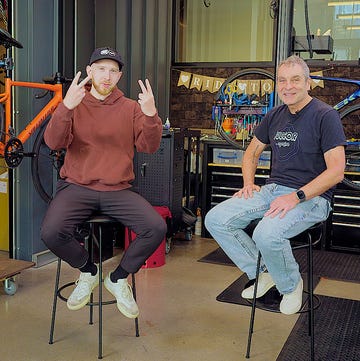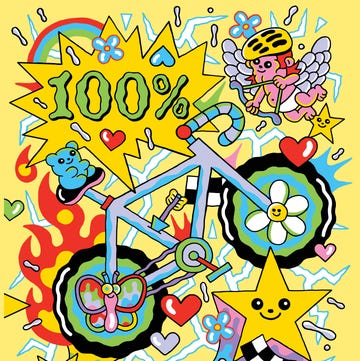Properly lubing a bicycle chain is surprisingly tricky. That’s because you’re not trying to lube the link plates; you want the lube to get inside the rollers. A thick layer of lubricant on the chain's surface may seem like a job well done, but it actually represents wasted lubricant and money. Plus, lube on the chain’s surface attracts dirt, which increases friction and wears your drivetrain more quickly.
Search around for tools and accessories designed to help you apply lube to a chain, and you will find that almost all of them are spray-and-pray (that some of the lube makes it into the rollers) gizmos that simply smear a bunch of lube on the exterior of the chain.
Hot waxing systems like Silca’s are an exception. However, the equipment is somewhat expensive, and the process is involved and requires removing the chain from the bike. Moreover, Silca’s system is for hot wax, not liquid lubes.
That’s why the best tools we’ve had to help us properly lube a chain are a needle tip for the lube bottle, plus patience (and good eyesight). But individually dripping a bit of lube on every roller and then working it inside the rollers is tedious. It’s 2025: How is there not a better way.
James Cooke asked himself that question. “I had a big crash on my mountain bike and had a few months of recovery. I was working on my bike and while lubing the chain I thought there must be a better way. I did an internet search and found a couple of products. I tried them and was not satisfied. I started prototyping my first idea and just kept progressing from there.”
He calls his tool the Rotaluber. I’m still early into my evaluation, but the Rotaluber might be the first tool to help you helps you properly lubricate a bicycle chain with liquid lube quickly and easily.
The 3D-printed tool has a toothed wheel—James calls it a “sprocket roller”— with four sets of tiny ports in the valleys between the teeth. These ports align with the outside edges of the chain’s rollers. This crucial detail makes it different from other lubricant application tools: The Rotaluber only deposits lubricant on the rollers.
A clever detail about the tool is it the lube does not squirt out of all ports at once: “Oil passes from the bottle, through the tool, to the hole in the axle. Only the hole in the sprocket roller positioned over the chain roller lines up with the hole in the axle, allowing the oil to pass through only at that position,” said Cooke. This element of the Rotaluber’s design helps it operate cleanly without wasting expensive lubricant.
The second important part of the tool is a simple rubber strip. After the tool deposits lube on the roller, the chain passes over the rubber strip. The strip spins the rollers, helping to draw the lube inside.
To use the Rotaluber, you engage the tool on the chain, backpedal, and gently squeeze the bottle. After lubing the full length of the chain—using the chain’s quick link as a marker—you do another full pass of the chain through the tool without squeezing the bottle.
And that’s it: two chain revolutions and a squeeze. It’s fast—much faster than dripping lube on every individual roller—it is easy, it’s clean (mostly, more on this soon), and, based on my initial uses, the lube gets into the rollers where it’s most effective without coating the outside of the chain in a bunch of wasted lube.
The tool’s single adjustment is a dial that you use to adjust the flow rate of the lube through the ports. Use this to prevent over-lubricating the chain and to accommodate different lube viscosities.
So far, I’ve found one shortcoming when using the tool. It's easy to apply too much pressure on the bottle, causing the lubricant to backflow out of the connection between it and the tool. This causes a mess and gets lube all over your hand.
I passed this feedback to Cooke, he expressed surprise. We’re currently troubleshooting the situation. He asked me for pictures and details so he can look into a potential QC problem.
Extra care is needed when using the tool with wax lubes like Silca Super Secret because they dry quickly and can clog the Rotaluber. After lubing with a liquid wax, cap the bottle immediately and rinse the tool.
The Rotaluber significantly streamlines and speeds up the application of liquid lubricant. However, it's still essential to follow all the proper steps: clean the chain thoroughly before lubricating, apply at the right time (after finishing a ride, not just before starting), and wipe off any excess lube before you begin riding.
While the Rotaluber does not eliminate those steps, I've found, compared to the traditional application method, it applies far less excess lubricant to remove at the wiping step. And that means it saves money because you’re not throwing away unused lube.
The Rotaluber sells for $40 (shipping is currently free) with one bottle (and mixing bauble) and a “benchtop stand.” I’m pretty sure the “stand” is a flanged rubber gasket from a plumbing supply store, but it does the job. Spare lube bottles are $2.00 each. If you have different lubes for different conditions or bikes, you can have Rotaluber bottles prefilled and at the ready.
I’m not ready to declare the Rotaluber a game-changing product that will forever improve how we lube chains. Not yet anyway. We’ll see how I feel after using it for a few months. But this is a clever and effective solution like we’ve never had before; for that reason alone, it is a wonder.

A gear editor for his entire career, Matt’s journey to becoming a leading cycling tech journalist started in 1995, and he’s been at it ever since; likely riding more cycling equipment than anyone on the planet along the way. Previous to his time with Bicycling, Matt worked in bike shops as a service manager, mechanic, and sales person. Based in Durango, Colorado, he enjoys riding and testing any and all kinds of bikes, so you’re just as likely to see him on a road bike dressed in Lycra at a Tuesday night worlds ride as you are to find him dressed in a full face helmet and pads riding a bike park on an enduro bike. He doesn’t race often, but he’s game for anything; having entered road races, criteriums, trials competitions, dual slalom, downhill races, enduros, stage races, short track, time trials, and gran fondos. Next up on his to-do list: a multi day bikepacking trip, and an e-bike race.


















